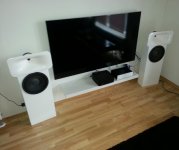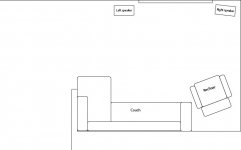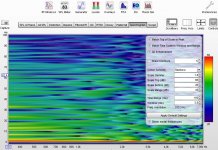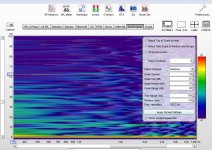Hi!
I need to measure my speakers, and create a suitable crossover, as well as room correction etc. (everything is done digitaly through miniDSP).
But before doing so, I would love to get some input on which approach is best used for this purpose, when the speakers will be measured in-room.
How would you approach this issue?
I need to measure my speakers, and create a suitable crossover, as well as room correction etc. (everything is done digitaly through miniDSP).
But before doing so, I would love to get some input on which approach is best used for this purpose, when the speakers will be measured in-room.
How would you approach this issue?
Attachments
Last edited:
Hi!
I need to measure my speakers, and create a suitable crossover, as well as room correction etc. (everything is done digitaly through miniDSP).
But before doing so, I would love to get some input on which approach is best used for this purpose, when the speakers will be measured in-room.
How would you approach this issue?
Start buying a microphone like an Umik 1 and download REW
cheers ,
Rens
I already have the equipment 
What I need input on, is these matters:
For crossover:
- Placement of speakers when measuring (idle, middle of room, etc)
- Placement of microphone in relation to speakers (height, distance from driver etc)
For room correction:
- Measure each speaker individually, or together?
- Placement of microphone in relation to speakers
- Multiple measurements from different areas in the room?
- Correct response for each speaker individually, or together?
For crossover, I have previously I have measured each speaker in the middle of the room, 1m distance from drivers, with height equal to the horn.
But I am unsure if this is the most correct way to approach this.
For room correction, I have previously done several measurements in different listening posisions, and created an average graph, which I then use to correct frequency anomalies.
What I need input on, is these matters:
For crossover:
- Placement of speakers when measuring (idle, middle of room, etc)
- Placement of microphone in relation to speakers (height, distance from driver etc)
For room correction:
- Measure each speaker individually, or together?
- Placement of microphone in relation to speakers
- Multiple measurements from different areas in the room?
- Correct response for each speaker individually, or together?
For crossover, I have previously I have measured each speaker in the middle of the room, 1m distance from drivers, with height equal to the horn.
But I am unsure if this is the most correct way to approach this.
For room correction, I have previously done several measurements in different listening posisions, and created an average graph, which I then use to correct frequency anomalies.
Last edited:
Start with Wikipedia Loudspeaker measurement - Wikipedia, the free encyclopedia
The REW Help files are fantastic!
It takes perhaps half a year to start guessing what happens with each measurement setup. Do lots of tests an cross checks. Select a reference speaker that you use sometimes for quality control, any good two-way will do (and don't modify it at all!). Looka at several IR gates, several smoothings and sleep over!
Remember to check phase, distortion and group delay too, not just amplitude response. I strongly advice you to go outdoors to set xo properly (response/slope symmetry, phase match/delays)
Reflections are a nuisance below 600Hz indoors. Measuring distance means a lot too. If you measure the speaker on a stand and/or outdoors, remember that the room placement will boost bass and you will always have at least floor reflection (Fs depending on your measuring distance) - don't try to get bass straight as low as possible but perhaps slowly declining below 200Hz.
Your room looks rather "naked" acoustically and the speakers are close to boundaries. Also the back wall will give lots of reflections! Room measurements will make you frustrated, I promise!
The REW Help files are fantastic!
It takes perhaps half a year to start guessing what happens with each measurement setup. Do lots of tests an cross checks. Select a reference speaker that you use sometimes for quality control, any good two-way will do (and don't modify it at all!). Looka at several IR gates, several smoothings and sleep over!
Remember to check phase, distortion and group delay too, not just amplitude response. I strongly advice you to go outdoors to set xo properly (response/slope symmetry, phase match/delays)
Reflections are a nuisance below 600Hz indoors. Measuring distance means a lot too. If you measure the speaker on a stand and/or outdoors, remember that the room placement will boost bass and you will always have at least floor reflection (Fs depending on your measuring distance) - don't try to get bass straight as low as possible but perhaps slowly declining below 200Hz.
Your room looks rather "naked" acoustically and the speakers are close to boundaries. Also the back wall will give lots of reflections! Room measurements will make you frustrated, I promise!
I'm not any sort of guru, but here's what I've been doing for crossover design measurements when restricted to indoors, for 2-way. For the most part, these are all impulse MLS with 5 averages, time-gated, converted to FR with min. phase. Checking the results with different gate times frequently is needed at first:
- Find placement that allows gate time to be set as long as possible without seeing reflections affect the response more than I need to care about for whatever I'm working on. Often this is pointed at the ceiling from the middle of the room, for me. Using that placement, or a more convenient placement that is still good enough for the following...
- establish on several axes the measuring distance needed where each driver response is no longer changing its tilt and etc. Start with the woofer axis, note when it stops changing, move up to the midpoint between drivers, and if it changes, move back farther and note the safe midpoint distance too. Then switch to the HF and if it needs any farther distances for on-axis and/or the midpoint axis, note those instead. This comes back in the last part.
- from that min. distance, take sets of measurements moving off axis in 5-10° increments (to establish/confirm crossover range, and spot off-axis problems).
- still from that distance or a bit farther, measure the woofer in lots of placements in various ways that reach into the bass range (long gates, dual gates, RTA with periodic pink noise). Use these to determine the highest frequency I can safely use as a reference for base SPL in crossover design.
- back at the most reflection-free placement, on-axis midpoint between drivers, take measurements gated just long enough to reach the reference frequency established. Check if longer gate preserves clean response, and if so increase mic distance and/or gate time. Or, if reference frequency can't even be reached without reflections, switch to the min-distance on driver axes instead of taking all measurements from midpoint, or find a better location. These are the crossover design measurements, so need to be taken with min phase and any smoothing desired.
- Find placement that allows gate time to be set as long as possible without seeing reflections affect the response more than I need to care about for whatever I'm working on. Often this is pointed at the ceiling from the middle of the room, for me. Using that placement, or a more convenient placement that is still good enough for the following...
- establish on several axes the measuring distance needed where each driver response is no longer changing its tilt and etc. Start with the woofer axis, note when it stops changing, move up to the midpoint between drivers, and if it changes, move back farther and note the safe midpoint distance too. Then switch to the HF and if it needs any farther distances for on-axis and/or the midpoint axis, note those instead. This comes back in the last part.
- from that min. distance, take sets of measurements moving off axis in 5-10° increments (to establish/confirm crossover range, and spot off-axis problems).
- still from that distance or a bit farther, measure the woofer in lots of placements in various ways that reach into the bass range (long gates, dual gates, RTA with periodic pink noise). Use these to determine the highest frequency I can safely use as a reference for base SPL in crossover design.
- back at the most reflection-free placement, on-axis midpoint between drivers, take measurements gated just long enough to reach the reference frequency established. Check if longer gate preserves clean response, and if so increase mic distance and/or gate time. Or, if reference frequency can't even be reached without reflections, switch to the min-distance on driver axes instead of taking all measurements from midpoint, or find a better location. These are the crossover design measurements, so need to be taken with min phase and any smoothing desired.
http://audio.claub.net/tutorials/FR measurement using ARTA.pdf
has some good tips on measuring even if you don't use ARTA.
has some good tips on measuring even if you don't use ARTA.
Last edited:
Just use HOLM
You get same measurements from all major software but HOLM is by far easiest to use and has best UI.
You also need some tool to generate target responses. F.e. 24db LR hipass...
Then you overlay target and actual measurement in holm and make adjustments till it fit target /individual drivers/
Best location is that where first reflection is as far as possible. Your setup looks like easy movable to outside place your speaker facing to sky at same distance from ground as backwall in room will be. Tune it to flat at this condition. In room under 100hz make shelve "by ear" Dont do any room correction above 50hz. Then you can shelve highs by ear to suit your needs.
You get same measurements from all major software but HOLM is by far easiest to use and has best UI.
You also need some tool to generate target responses. F.e. 24db LR hipass...
Then you overlay target and actual measurement in holm and make adjustments till it fit target /individual drivers/
Best location is that where first reflection is as far as possible. Your setup looks like easy movable to outside place your speaker facing to sky at same distance from ground as backwall in room will be. Tune it to flat at this condition. In room under 100hz make shelve "by ear" Dont do any room correction above 50hz. Then you can shelve highs by ear to suit your needs.
Holm and ARTA have more technical UI than REW, too much for me but fine for experienced users. The licenced ARTA is the tool to make directivity sonograms and eg. STI analysis. STEPS is sibling of ARTA and is a valuable tool too.
REW hs also decay spectrogram, it is very useful for seeing the room reflections at various frequencies, just set gating narrow.
REW hs also decay spectrogram, it is very useful for seeing the room reflections at various frequencies, just set gating narrow.
Attachments
After some reading, it seems like near field measurements of each driver, then combine them into one graph, is the best compromise when doing in-room measurements. That way you minimize/remove the room's impact on the measurements right?
When using 48 db/octave filters, phase also becomes more or less a non issue, correct?
When using 48 db/octave filters, phase also becomes more or less a non issue, correct?
Do you mean for the low bass response? Yes, you can do that and probably should. You'll have to measure the port output separately too. If you mean for the response beyond the low bass, then no. Nearfield response will be way off, especially with a large driver and large waveguide like you've got there. You'll see that if you follow the advice of that dumptruck guy up thereAfter some reading, it seems like near field measurements of each driver, then combine them into one graph, is the best compromise when doing in-room measurements. That way you minimize/remove the room's impact on the measurements right?
(I meant the minimum distance needed).- establish on several axes the measuring distance needed where each driver response is no longer changing its tilt and etc.
Phase tracking between drivers becomes a relatively small issue, but you still want need them to end up in phase at the crossover point from somewhere close to straight out from the midpoint. Otherwise your driver overlap becomes a problem that you can't EQ properly.When using 48 db/octave filters, phase also becomes more or less a non issue, correct?
Last edited:
I find this to be another (VIDEO) resource, (tell me if good or not, I didn't have the time yet). 
RMAF11: Loudspeaker Measurements Explained, John Atkinson, Stereophile Editor - YouTube
RMAF11: Loudspeaker Measurements Explained, John Atkinson, Stereophile Editor - YouTube
- Status
- This old topic is closed. If you want to reopen this topic, contact a moderator using the "Report Post" button.
- Home
- General Interest
- Room Acoustics & Mods
- In-room measurements - Which approach?



